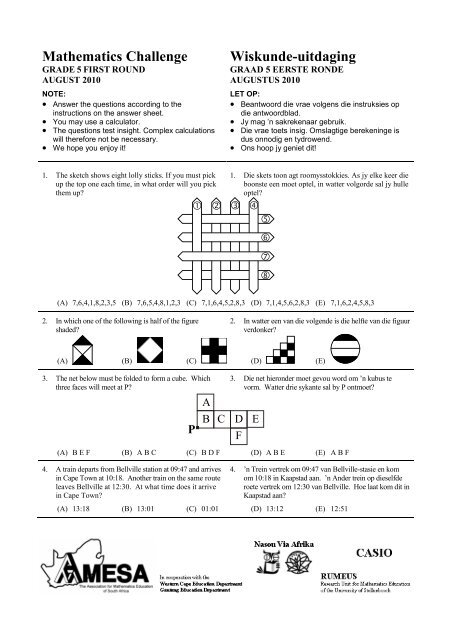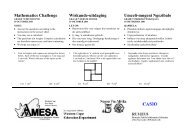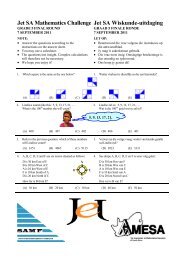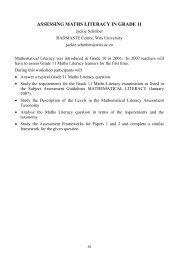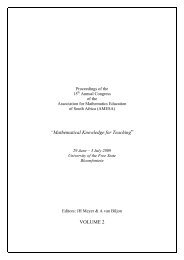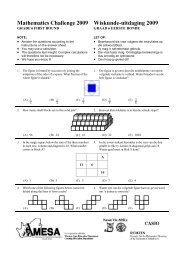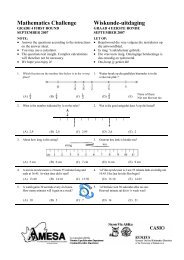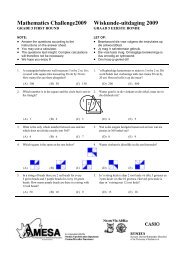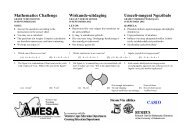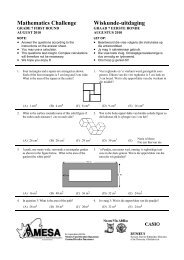Mathematics Challenge Wiskunde-uitdaging - AMESA
Mathematics Challenge Wiskunde-uitdaging - AMESA
Mathematics Challenge Wiskunde-uitdaging - AMESA
You also want an ePaper? Increase the reach of your titles
YUMPU automatically turns print PDFs into web optimized ePapers that Google loves.
<strong>Mathematics</strong> <strong>Challenge</strong><br />
GRADE 5 FIRST ROUND<br />
AUGUST 2010<br />
NOTE:<br />
• Answer the questions according to the<br />
instructions on the answer sheet.<br />
• You may use a calculator.<br />
• The questions test insight. Complex calculations<br />
will therefore not be necessary.<br />
• We hope you enjoy it!<br />
<strong>Wiskunde</strong>-<strong>uitdaging</strong><br />
GRAAD 5 EERSTE RONDE<br />
AUGUSTUS 2010<br />
LET OP:<br />
• Beantwoord die vrae volgens die instruksies op<br />
die antwoordblad.<br />
• Jy mag ’n sakrekenaar gebruik.<br />
• Die vrae toets insig. Omslagtige berekeninge is<br />
dus onnodig en tydrowend.<br />
• Ons hoop jy geniet dit!<br />
1. The sketch shows eight lolly sticks. If you must pick<br />
up the top one each time, in what order will you pick<br />
them up<br />
1. Die skets toon agt roomysstokkies. As jy elke keer die<br />
boonste een moet optel, in watter volgorde sal jy hulle<br />
optel<br />
<br />
<br />
<br />
<br />
<br />
(A) 7,6,4,1,8,2,3,5 (B) 7,6,5,4,8,1,2,3 (C) 7,1,6,4,5,2,8,3 (D) 7,1,4,5,6,2,8,3 (E) 7,1,6,2,4,5,8,3<br />
2. In which one of the following is half of the figure<br />
shaded<br />
2. In watter een van die volgende is die helfte van die figuur<br />
verdonker<br />
(A) (B) (C) (D) (E)<br />
3. The net below must be folded to form a cube. Which<br />
three faces will meet at P<br />
P<br />
3. Die net hieronder moet gevou word om ’n kubus te<br />
vorm. Watter drie sykante sal by P ontmoet<br />
(A) B E F (B) A B C (C) B D F (D) A B E (E) A B F<br />
4. A train departs from Bellville station at 09:47 and arrives<br />
in Cape Town at 10:18. Another train on the same route<br />
leaves Bellville at 12:30. At what time does it arrive<br />
in Cape Town<br />
A<br />
B C D E<br />
F<br />
4. ’n Trein vertrek om 09:47 van Bellville-stasie en kom<br />
om 10:18 in Kaapstad aan. ’n Ander trein op dieselfde<br />
roete vertrek om 12:30 van Bellville. Hoe laat kom dit in<br />
Kaapstad aan<br />
(A) 13:18 (B) 13:01 (C) 01:01 (D) 13:12 (E) 12:51
Grade 5 (First Round) Page 2 of 4<br />
5. If you begin with a certain one-digit number, multiply it<br />
by 3, then add 8, then divide by 2 and then subtract 6,<br />
you will get the original number as answer. What is the<br />
number<br />
5. As jy begin met 'n sekere eensyfer-getal, dit vermeningvuldig<br />
met 3, dan 8 bytel, dan deel deur 2 en dan 6<br />
aftrek, sal jy die oorspronklike getal as antwoord kry.<br />
Wat is die getal<br />
(A) 2 (B) 8 (C) 6 (D) 5 (E) 4<br />
6. At a fun fair an ice-cream vendor sells 25 cones, which is<br />
12 less than he sold yesterday. How many did he sell<br />
yesterday<br />
6. By ’n kermis verkoop ’n roomyswaentjie 25 roomyse,<br />
wat 12 minder is as wat hy gister verkoop het. Hoeveel<br />
roomyse het hy gister verkoop<br />
(A) 13 (B) 37 (C) 24 (D) 50 (E)<br />
None of these<br />
Nie een hiervan nie<br />
7. Calculate:<br />
2 – 1 + 3 – 2 + 4 – 3 + 5 – 4 + 6 – 5 + … + 101 – 100<br />
7. Bereken:<br />
2 – 1 + 3 – 2 + 4 – 3 + 5 – 4 + 6 – 5 + … + 101 – 100<br />
(A) 99 (B) 100 (C) 101 (D) 102 (E) 201<br />
8. You and your friend have the same amount of money.<br />
How much should you give her so that she has R10 more<br />
than you<br />
8. Jy en jou maat het ewe veel geld. Hoeveel moet jy haar<br />
gee sodat sy R10 meer as jy het<br />
(A) R15 (B) R10 (C) R20 (D) R5 (E)<br />
None of these<br />
Nie een hiervan nie<br />
9. Hailey is reading a book. Chapter 7 begins on page 246<br />
and ends on page 274. How many pages are there in<br />
chapter 7<br />
9. Hailey lees ’n boek. Hoofstuk 7 begin op bladsy 246 en<br />
eindig op bladsy 274. Hoeveel bladsye is daar in<br />
hoofstuk 7<br />
(A) 274 (B) 28 (C) 15 (D) 29 (E) 30<br />
10. Rectangles with sides 3 cm and 1 cm are used to make<br />
the figure below. How far is it once around the figure<br />
10. Reghoeke met sye 3 cm en 1 cm word gebruik om die<br />
onderstaande figuur te vorm. Hoe ver is dit een keer<br />
rondom die figuur<br />
3 cm<br />
1 cm<br />
(A) 24 cm (B) 48 cm (C) 26 cm (D) 14 cm (E) 32 cm<br />
11. Thomas forgot to take off his shoes when he got onto the<br />
scale to weigh himself. The scale showed 41 kg. He<br />
then weighed his two shoes and found that they had a<br />
mass of 725 g. What was his mass without his shoes<br />
11. Thomas het vergeet om sy skoene uit te trek voor hy op<br />
die skaal geklim het om homself te weeg. Die skaal het<br />
41 kg gewys. Toe weeg hy sy twee skoene en vind dat<br />
hulle ’n massa van 725 g het. Wat was sy massa sonder<br />
sy skoene<br />
(A) 40,175 g (B) 40,725 kg (C) 39,275 kg (D) 41,725 kg (E) 40,275 kg<br />
12. A factory manufactures dresses and shirts:<br />
3 dresses are manufactured for every 4 shirts. In a week<br />
the factory produced a total of 420 dresses and shirts.<br />
How many of these were dresses<br />
12. ’n Fabriek vervaardig rokke en hemde: vir elke 3 rokke<br />
word 4 hemde vervaardig. Gedurende ’n week word<br />
altesaam 420 rokke en hemde vervaardig. Hoeveel<br />
hiervan is rokke<br />
(A) 180 (B) 240 (C) 140 (D) 315 (E) 120
Grade 5 (First Round) Page 3 of 4<br />
13. On a digital clock displaying hours, minutes and<br />
seconds, how many times in each 24-hour period do all<br />
six digits change simultaneously<br />
13. Op ’n digitale horlosie wat ure, minute en sekondes<br />
vertoon, hoeveel keer in elke 24-uur tydperk verander al<br />
ses syfers gelyktydig<br />
(A) 0 (B) 1 (C) 2 (D) 3 (E) 24<br />
14. I choose three numbers from this number square – one<br />
number from each row and one number from each<br />
column. Then I multiply the three numbers. What is the<br />
largest possible product<br />
14. Ek kies drie getalle uit hierdie getalvierkant – een getal<br />
uit elke ry en een getal uit elke kolom. Dan<br />
vermenigvuldig ek die drie getalle. Wat is die grootste<br />
moontlike produk<br />
1 2 3<br />
4 5 6<br />
7 8 9<br />
(A) 72 (B) 96 (C) 105 (D) 162 (E) 504<br />
15. Sipho uses dots to build T-shapes as shown below. How<br />
many dots will he use for T 50 <br />
15. Sipho bou T-vorms met kolletjies soos hieronder.<br />
Hoeveel kolletjies sal hy gebruik vir T 50 <br />
T 1 T 2 T 3 T 4<br />
(A) 101 (B) 201 (C) 500 (D) 151 (E) 501<br />
16. Sipho uses tiles to build crosses as shown below. How<br />
many tiles will he use for X 50 <br />
16. Sipho bou kruise met teëls soos hieronder. Hoeveel<br />
teëls sal hy gebruik vir X 50 <br />
X 1 X 2 X 3 X 4 X 5<br />
(A) 202 (B) 201 (C) 200 (D) 210 (E) 212<br />
17. Sally counts like this: 6, 10, 14, 18, 22, 26, 30, ...<br />
What is the 100 th number she will count<br />
17. Sally tel so: 6, 10, 14, 18, 22, 26, 30, ...<br />
Wat is die 100 ste getal wat sy sal tel<br />
(A) 602 (B) 402 (C) 403 (D) 404 (E) 405<br />
18. If Sally continues to count like this, which of these<br />
numbers will she count<br />
18. As Sally voortgaan om so te tel, watter van hierdie<br />
getalle sal sy tel<br />
(A) 8372 (B) 9756 (C) 9676 (D) 7952 (E) 7578
Grade 5 (First Round) Page 4 of 4<br />
19. Vusi builds a sequence of triangular patterns with matches<br />
as shown. In T 1 there is one triangle and in T 2 there are<br />
four triangles. How many triangles are there in T 10 <br />
19. Vusi bou ’n ry driehoekpatrone met vuurhoutjies soos<br />
hieronder. In T 1 is daar een driehoek. In T 2 is daar vier<br />
driehoeke. Hoeveel driehoeke is daar in T 10 <br />
T 1 T 2 T 3<br />
(A) 30 (B) 60 (C) 100 (D) 120 (E) 121<br />
20. In question 19, T 1 has three matches and T 2 has<br />
9 matches. How many matches does Sipho need to build<br />
pattern T 10 <br />
20. In vraag 19 : T 1 het drie vuurhoutjies en T 2 het<br />
9 vuurhoutjies. Hoeveel vuurhoutjies het Sipho nodig om<br />
T 10 te bou<br />
(A) 150 (B) 180 (C) 135 (D) 165 (E) 300<br />
21. The desks in a classroom are arranged in straight rows<br />
with the same number of desks in each row. Unless<br />
someone is absent, each desk is filled. Masaki is in the<br />
second row from the front and the fourth row from the<br />
back. She is also the third learner from the left end of the<br />
row and the fifth learner from the right. How many<br />
learners are in the class<br />
21. Die banke in ’n klaskamer staan in ewe lang reguit rye.<br />
Behalwe as iemand afwesig is, is al die banke gevul.<br />
Masaki sit in die tweede ry van voor af en in die vierde<br />
ry van agter af. Sy is ook die derde leerling van links af<br />
en die vyfde leerling van regs af. Hoeveel leerlinge is<br />
daar in die klas<br />
(A) 48 (B) 35 (C) 30 (D) 24 (E) 42<br />
22. A, B, C, D, E and F are six towns situated as follows:<br />
D is 30 km East of F<br />
B is 20 km West of C<br />
A is 10 km West of E<br />
F is 10 km South of A<br />
D is 20 km North of C<br />
How far is B from E<br />
22. Ses dorpe A, B, C, D, E en F is soos volg geleë:<br />
D is 30 km Oos van F<br />
B is 20 km Wes van C<br />
A is 10 km Wes van E<br />
F is 10 km Suid van A<br />
D is 20 km Noord van C<br />
Hoe ver is B van E<br />
(A) 30 km (B) 20 km (C) 10 km (D) 40 km (E) 50 km<br />
23. Jackie has four cards (see below). How many different<br />
two-digit numbers can she make with these cards<br />
23. Jackie het vier kaarte (sien hieronder). Hoeveel<br />
verskillende tweesyfer-getalle kan sy met hierdie kaarte<br />
maak<br />
(A) 8 (B) 12 (C) 16 (D) 18 (E) 24<br />
24. In question 23: How many different three-digit numbers<br />
can Jackie make with these cards<br />
24. In vraag 23: Hoeveel verskillende driesyfer-getalle kan<br />
Jackie met hierdie kaarte maak<br />
(A) 8 (B) 12 (C) 16 (D) 18 (E) 24<br />
25. Peter, Tom, Robert and Debbie are standing in a queue at<br />
the Post Office counter. If Peter leaves, Tom is in the<br />
second place. If Debbie leaves, Peter is first in the queue.<br />
Who is fourth in the queue<br />
25. Peter, Tom, Robert en Debbie staan in 'n tou by 'n<br />
toonbank in die Poskantoor. As Peter loop, is Tom in die<br />
tweede plek. As Debbie loop, is Peter voor in die tou.<br />
Wie is vierde in die tou<br />
(A) Robert (B) Peter (C) Debbie (D) Tom (E)<br />
Not enough information<br />
Nie genoeg inligting nie


